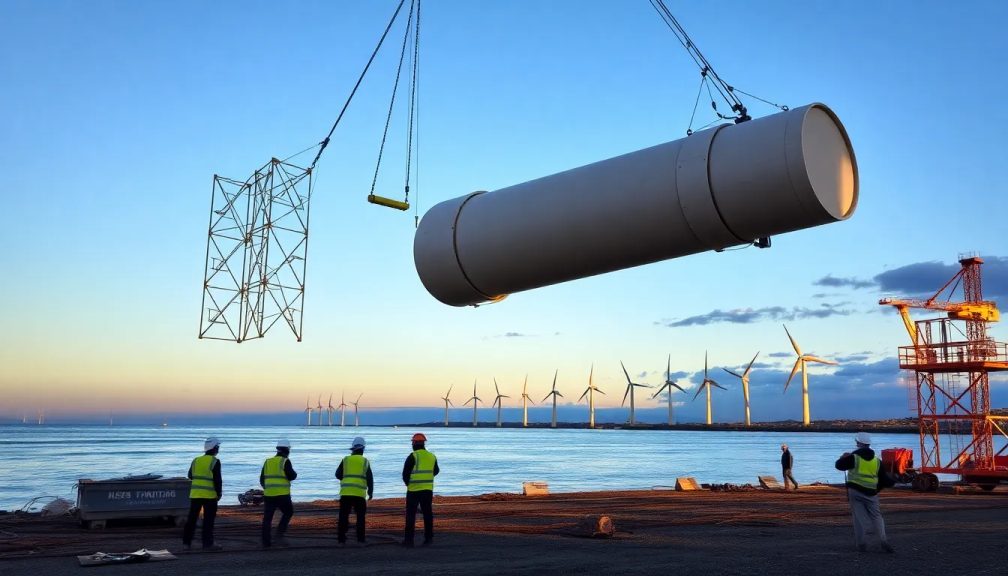Judge Allows Construction to Resume on Offshore Wind Farm

The ongoing debate surrounding offshore wind farms continues to gain traction as legal battles unfold and public sentiment fluctuates. With the increasing urgency to transition to renewable energy sources, understanding the implications of these projects has never been more critical. This article delves into the complex dynamics of offshore wind development, focusing on recent legal rulings and public opinions that shape the future of this industry.
Legal challenges facing offshore wind projects
Offshore wind farms have emerged as a pivotal solution in the fight against climate change, harnessing the power of coastal winds for sustainable energy. However, these projects often face significant legal and bureaucratic hurdles. The recent case involving the Revolution Wind project in the Atlantic exemplifies such challenges.
In a notable ruling, a federal judge intervened to allow construction on the Revolution Wind project to resume after a temporary halt imposed by the previous administration. This decision was rooted in the judge's assessment of the government's actions as “the height of arbitrary and capricious,” indicating a lack of substantial justification for the work stoppage.
Key points from the court ruling include:
- The judge issued a preliminary injunction, enabling the developer, Ørsted, to restart construction immediately.
- The Revolution Wind project was reported to be 80% complete at the time of the halt, making the court's decision all the more significant.
- Judge Royce Lamberth emphasized the urgency of moving forward with renewable energy initiatives.
Public perception of offshore wind farms
Despite the legal victories for offshore wind projects, public sentiment remains mixed. Many people support the transition to renewable energy but express concerns about the environmental and visual impact of wind farms. This duality creates tension in communities where these projects are proposed.
Common concerns include:
- Impact on marine and bird life, with fears of disrupting habitats.
- Visual pollution, as some residents are opposed to the sight of wind turbines on the horizon.
- Potential negative effects on local fishing industries.
Nevertheless, proponents argue that the benefits of offshore wind energy, such as reduced carbon emissions and job creation in the green energy sector, outweigh these concerns.
Comparative analysis of offshore wind projects
Offshore wind farms vary significantly in scale, technology, and environmental considerations. For example, projects like Revolution Wind are designed to leverage advanced turbine technology and strategic locations to maximize energy output while minimizing ecological disruption.
To better understand the differences, consider the following aspects:
| Project Name | Location | Capacity (MW) | Completion Status |
|---|---|---|---|
| Revolution Wind | Rhode Island | 704 | 80% complete |
| SouthCoast Wind | Massachusetts | 1,200 | In development |
| Atlantic Shores | New Jersey | 1,510 | In development |
This comparison highlights the diversity of offshore wind projects and their varying stages of development, reflecting the broader national strategy to increase renewable energy capacity.
Why some oppose offshore wind farms
While the push for offshore wind energy is robust, there are several reasons why communities and individuals express opposition to these developments. Understanding these objections can provide insight into the broader conversation about renewable energy.
- Environmental concerns: There is apprehension about the potential harm to marine ecosystems and wildlife, particularly migratory bird species.
- Noise pollution: Some residents fear that the noise generated by turbine operations could disrupt local communities.
- Property values: Concerns exist that proximity to wind farms may decrease property values in neighboring areas.
The challenges faced by offshore wind developments underscore the need for careful planning and community engagement to address these concerns effectively.
Future outlook for offshore wind energy
The future of offshore wind energy appears promising, especially in light of recent legal victories and increasing public awareness of climate issues. As technology advances and more projects come online, the potential for offshore wind to play a pivotal role in energy generation grows.
Factors influencing this positive outlook include:
- Government incentives and policies promoting renewable energy.
- Technological advancements that improve efficiency and reduce costs.
- Growing public support for sustainable energy solutions.
As developers, policymakers, and communities navigate the complexities of offshore wind projects, ongoing discussions will be essential to ensure a balanced approach that addresses environmental, economic, and social considerations.




Leave a Reply